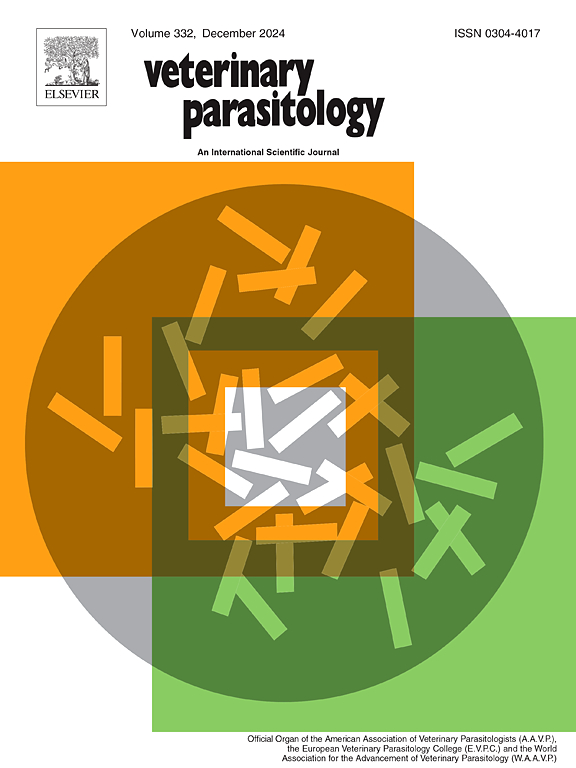Comparative efficacy of imidocarb dipropionate with additive in naturally infected cattle against bovine babesiosis
IF 2
2区 农林科学
Q2 PARASITOLOGY
引用次数: 0
Abstract
Babesiosis is a tick borne disease prevalent worldwide. The present study was planned to evaluate the therapeutic efficacy of imidocarb dipropionate alone and with additive milk, cumin, and jetepar syrup in naturally Babesia-infected cattle. Blood samples (n = 300) were collected from the selected cattle. Age, breed, dung pile location, use of acaricides, temperature, health status, tick infestation and housing type were also considered during sample collection. Out of 90 samples that were found positive through staining procedures, 45 were confirmed through PCR. As per infection rate observed more in exotic breed, the treatment trials were conducted on these cattle. These cattle were divided into three groups, each consisting of 15 cattle. Group 1 was treated with imidocarb dipropionate. Group 2 was treated with imidocarb dipropionate and additives (milk, cumin, and jetepar syrup). Group 3 was the infected, non-medicated group, and group 4 consisted of healthy, non-infected cattle (n = 15).The cattle were subjected to liver function tests and recorded milk production before and after treatment. The afore-mentioned factorsi.e. age (<3 years), Holstein Friesian breed, with dung piles near their living area, without acaricides use, poor health status, tick infestation, and tethered housing system were found significant associated with babesiosis in the cattle. Cattle in G1 treated with imidocarb dipropionate showed an efficacy of 60 %. G2, on the other hand, showed 90 % efficacy. The cattle in G3, did not recover and two died. All cattle in G4, remained health. It was concluded that the cattle treated with imidiocarb dipropionate as well as additives showed better and rapid recovery.
二丙酸咪虫威与添加剂在自然感染牛中防治牛巴贝斯虫病的比较效果
巴贝斯虫病是一种在世界范围内流行的蜱传疾病。本研究计划评估单独使用二丙酸咪虫威和添加牛奶、孜然和吉特帕尔糖浆对自然感染巴贝斯虫的牛的治疗效果。从选定的牛身上采集血样(n = 300)。在采集样本时,还考虑了年龄、品种、粪堆位置、杀螨剂使用情况、温度、健康状况、蜱患情况和住房类型。在90个染色呈阳性的样本中,有45个通过PCR得到了确认。鉴于外来品种的感染率较高,对这些牛进行了治疗试验。这些牛被分成三组,每组15头牛。第一组采用吡虫威二丙酸治疗。第2组采用二丙酸咪虫威和添加剂(牛奶、孜然、吉特帕尔糖浆)。第3组为感染、未用药组,第4组为健康、未感染的牛(n = 15)。对牛进行肝功能检查,并记录治疗前后的产奶量。上述因素。年龄(3岁)、荷斯坦弗里马品种、生活区域附近有粪堆、未使用杀螨剂、健康状况不佳、蜱虫侵扰和笼舍系住系统与牛的巴贝斯虫病显著相关。用二丙酸咪唑威处理G1期牛,有效率为60% %。另一方面,G2的有效率为90% %。G3的牛没有康复,两只死亡。G4的所有牛都保持健康。综上所述,经二丙酸吡虫威和添加剂处理后,牛的恢复速度更快,效果更好。
本文章由计算机程序翻译,如有差异,请以英文原文为准。
求助全文
约1分钟内获得全文
求助全文
来源期刊

Veterinary parasitology
农林科学-寄生虫学
CiteScore
5.30
自引率
7.70%
发文量
126
审稿时长
36 days
期刊介绍:
The journal Veterinary Parasitology has an open access mirror journal,Veterinary Parasitology: X, sharing the same aims and scope, editorial team, submission system and rigorous peer review.
This journal is concerned with those aspects of helminthology, protozoology and entomology which are of interest to animal health investigators, veterinary practitioners and others with a special interest in parasitology. Papers of the highest quality dealing with all aspects of disease prevention, pathology, treatment, epidemiology, and control of parasites in all domesticated animals, fall within the scope of the journal. Papers of geographically limited (local) interest which are not of interest to an international audience will not be accepted. Authors who submit papers based on local data will need to indicate why their paper is relevant to a broader readership.
Parasitological studies on laboratory animals fall within the scope of the journal only if they provide a reasonably close model of a disease of domestic animals. Additionally the journal will consider papers relating to wildlife species where they may act as disease reservoirs to domestic animals, or as a zoonotic reservoir. Case studies considered to be unique or of specific interest to the journal, will also be considered on occasions at the Editors'' discretion. Papers dealing exclusively with the taxonomy of parasites do not fall within the scope of the journal.
 求助内容:
求助内容: 应助结果提醒方式:
应助结果提醒方式:


